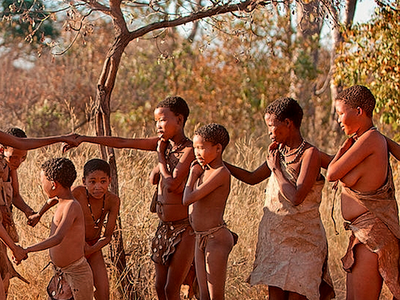Namibia, a country renowned for its breathtaking landscapes, vast deserts, and vibrant wildlife, is also home to one of the richest and most ancient human histories on the African continent. The Khoisan people, indigenous to southern Africa, are the earliest known inhabitants of Namibia and hold a significant place in the country’s cultural and historical narrative. With their deep connections to the land, rich traditions, and distinctive languages, the Khoisan’s influence on Namibia’s past and present cannot be overstated.
This article takes a deep dive into the ancient history of the Khoisan people, exploring their origins, way of life, cultural significance, and the lasting legacy they have left on Namibia and the broader southern African region. We will also examine the challenges they have faced throughout history and the ongoing efforts to preserve and honor their heritage.
1. Who are the Khoisan? Understanding the People
The term “Khoisan” is a collective label that refers to two distinct but historically interconnected groups: the Khoikhoi (also known as Khoi or Hottentots) and the San (also known as Bushmen). Both groups are believed to have been among the earliest human societies in southern Africa, with the Khoikhoi and San tracing their origins back at least 20,000 years.
The Khoikhoi People
The Khoikhoi were traditionally pastoralists, relying on the herding of cattle, sheep, and goats as their primary livelihood. They were highly skilled in animal husbandry and lived in semi-nomadic communities, moving with their herds in search of grazing land and water. Their social organization was based on extended family groups, with strong communal ties. The Khoikhoi people were also known for their distinctive beadwork, pottery, and leathercraft, which reflected their rich cultural heritage.
The San People
The San, on the other hand, were primarily hunter-gatherers, relying on the land’s natural resources for sustenance. They lived in small, mobile bands and developed highly sophisticated techniques for hunting, foraging, and survival in some of the harshest environments on earth. The San’s deep knowledge of the landscape, wildlife, and plant life allowed them to thrive in regions such as the Namib Desert, which would be inhospitable to many other peoples. San societies were egalitarian, with decision-making often being shared among the group, and their spiritual beliefs were deeply connected to the natural world.
Although distinct in their livelihoods, both the Khoikhoi and the San share a common linguistic and cultural heritage, which is reflected in their languages, customs, and traditions. The Khoisan languages, which are characterized by their distinctive click sounds, are among the oldest languages in the world, and many of these languages are still spoken by indigenous communities in Namibia today.
2. The Ancient History of the Khoisan in Namibia
The Khoisan people have inhabited southern Africa for tens of thousands of years, long before the arrival of Europeans. Archaeological evidence, such as rock art, tools, and burial sites, provides a window into the rich and ancient history of the Khoisan in Namibia. One of the most significant discoveries was made in the Twyfelfontein area in northwestern Namibia, where a UNESCO World Heritage Site features an extensive collection of rock engravings and paintings created by the San people.
Twyfelfontein is home to over 2,500 rock carvings and paintings, dating back to around 6,000 years ago. These artworks depict scenes of wildlife, spiritual rituals, and everyday life, offering insights into the beliefs, practices, and environmental knowledge of the San people. The rock art at Twyfelfontein is considered one of the most important examples of prehistoric art in Africa and is an essential part of Namibia’s cultural heritage.
In addition to rock art, the Khoisan also left behind a rich legacy of stone tools, pottery, and other artifacts that provide valuable insights into their way of life. These artifacts have been uncovered in various parts of Namibia, demonstrating the widespread presence of Khoisan communities throughout the region.
3. Khoisan Culture and Traditions
The Khoisan people have a rich cultural heritage, with distinct social structures, traditions, and customs that have been passed down through generations. Despite the challenges they have faced throughout history, including colonization, land dispossession, and marginalization, many Khoisan communities have managed to preserve their cultural practices and continue to pass them on to younger generations.
Languages and Oral Traditions
The Khoisan languages, particularly those spoken by the San people, are notable for their distinctive click sounds, which are not found in most other languages. These languages are part of the Khoisan language family, which is considered one of the oldest language families in the world. The clicks used in Khoisan languages are highly complex, involving a variety of different tongue and mouth movements, making them unique and difficult for outsiders to learn.
Oral traditions play a central role in Khoisan culture, as knowledge and stories are passed down through storytelling, songs, and rituals. Elders in the community are responsible for transmitting cultural knowledge, including historical narratives, moral lessons, and spiritual beliefs, to the younger generation. The importance of oral traditions is reflected in the rich storytelling culture of the Khoisan, which has preserved their history and way of life for millennia.
Spiritual Beliefs and Connection to the Land
The Khoisan have a profound spiritual connection to the land and nature, which is reflected in their beliefs and practices. The San, for example, believe in a spirit world that is inhabited by ancestors, spirits, and nature deities. Rituals and ceremonies are conducted to communicate with the spirit world and ensure harmony between the living and the dead. Shamans, or spiritual healers, play a central role in these rituals, using trance dances and other practices to facilitate spiritual experiences.
The Khoikhoi, like the San, also have a deep reverence for nature, with a strong belief in the interconnection between all living things. Their pastoralist lifestyle is based on a profound respect for the land, animals, and natural resources, and they have developed sustainable ways of managing their herds and environment.
Art and Craftsmanship
The Khoisan people are known for their artistic talents, particularly in the areas of beadwork, pottery, and leathercraft. Khoikhoi artisans, for example, create intricately beaded jewelry and adornments, which are used in ceremonies and as symbols of status within the community. San communities are also renowned for their craftsmanship in making tools, weapons, and baskets from natural materials found in their surroundings.
The rock art of the San, found at sites like Twyfelfontein, is perhaps the most famous artistic legacy of the Khoisan. These intricate engravings and paintings are not only artistic expressions but also carry cultural and spiritual significance, representing the interconnectedness of the Khoisan with their environment and the animal world.
4. Challenges Faced by the Khoisan People
Throughout history, the Khoisan people have faced significant challenges, many of which continue to affect them today. Colonization, land dispossession, forced labor, and discrimination during the apartheid era have all had a profound impact on Khoisan communities. The arrival of European settlers and the spread of colonialism in southern Africa led to the displacement of many Khoisan groups, as their land was seized for farming, mining, and settlement. The Khoikhoi were particularly affected by the expansion of European settlers, as their pastoral lifestyle was disrupted, and their livestock was confiscated.
The San people, being hunter-gatherers, were also heavily impacted by colonialism, as their nomadic way of life was incompatible with the growing agricultural settlements and territorial boundaries imposed by European powers. Many San were forcibly moved to reserves or incorporated into the labor force of colonial enterprises.
Under apartheid, Khoisan communities continued to face marginalization, as they were classified as “non-white” and subjected to discrimination and segregation. Many Khoisan people were forced to live in remote, economically deprived areas, and their cultural practices were often suppressed.
Modern-Day Challenges
In contemporary Namibia, the Khoisan continue to face social and economic challenges, including limited access to education, healthcare, and employment opportunities. Despite the country’s progress in achieving independence and promoting national unity, Khoisan communities often remain on the periphery of mainstream society.
Many Khoisan groups still struggle to preserve their cultural heritage, as younger generations move away from traditional practices in search of better opportunities in urban areas. The loss of traditional knowledge, combined with economic difficulties, has led to the erosion of cultural identity for some Khoisan people.
5. Preserving Khoisan Heritage: Efforts and Initiatives
In recent years, there has been a growing recognition of the need to preserve and promote the heritage of the Khoisan people in Namibia. Efforts have been made to document Khoisan languages, traditions, and history, and initiatives are underway to support Khoisan communities in maintaining their cultural practices. The government of Namibia, along with local and international organizations, has worked to raise awareness of the importance of Khoisan culture, advocating for the protection of sacred sites, such as the rock art at Twyfelfontein, and the promotion of Khoisan languages.
In addition, there is a growing movement among Khoisan communities to reclaim their rights and recognition as the indigenous people of Namibia. This includes campaigns for land rights, cultural recognition, and greater political representation. The Khoisan are increasingly asserting their place in the national narrative, seeking to ensure that their voices are heard and their cultural contributions are acknowledged.
The Khoisan people have left an indelible mark on Namibia’s cultural, historical, and environmental landscape. Their ancient presence in the region, their deep connection to the land, and their rich traditions have shaped the country in profound ways. Despite the challenges they have faced throughout history, the Khoisan continue to be a vital part of Namibia’s diverse heritage.
As Namibia looks to the future, it is essential that the country honors and preserves the legacy of the Khoisan people. By recognizing their contributions to Namibia’s history and ensuring the protection of their cultural practices, Namibia can ensure that the voices of the Khoisan are heard, their heritage is respected, and their traditions continue to thrive for generations to come. Through such efforts, Namibia can celebrate its ancient past while embracing the promise of a shared and inclusive future.
Join 'Namibia Today' WhatsApp Channel
Get the breaking news in Namibia — direct to your WhatsApp.
CLICK HERE TO JOIN












